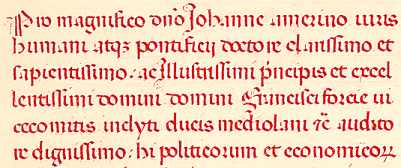Script Type : minuscule
Date : 15th century
Location : Italy
Function : Book hand of formal grade




























Distinctive letters : This can be described as a humanistic display script which still has much in common with formal Gothic book hands of the rotunda variety. Italian scribes never really adopted the highly compressed Gothic forms. This rounded hand mostly uses formal versions of the letters from Caroline minuscule, the script which was deliberately revived in the Italian Renaissance. Although not highly compressed, it retains some conjoined letter combinations such as do and be. Letters such as i, u, m and n are well separated however.
There are two forms of d, the backsloping Gothic form and the upright Caroline minuscule form. Both the upright r and the minimalistic r found after vowels appear, as do both the short and tall forms of s. The letter i is delicately dotted.
The letters i and j, as well as u and v are identical, as usual. There are no examples of w or z.
There are a few abbreviations in the text. Pass the cursor over the first few lines for a taste, and continue to the paleography exercises to examine it in more detail.
Paleography
exercises for this example using Flash ![]()
Requires Flash 5 plugin
If you are looking at this page without frames, there is more information about medieval writing to be found by going to the home page (framed) or the site map (no frames).